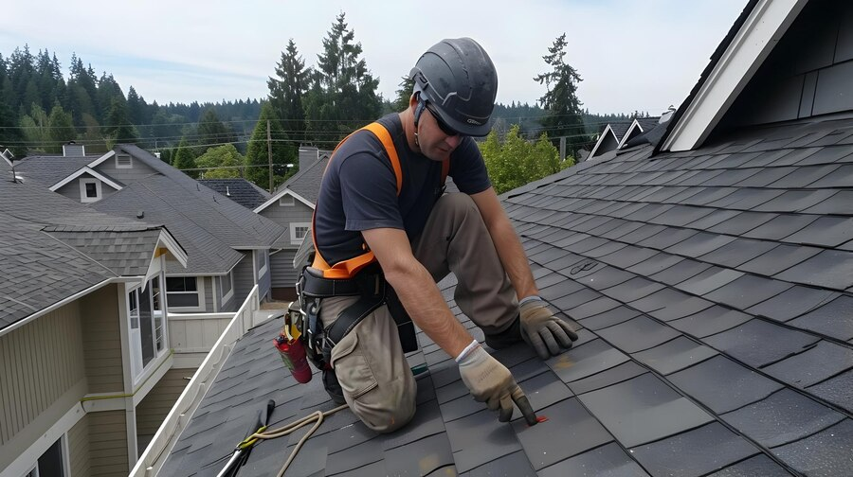If your roof has recently suffered damage and you’re facing the prospect of a full replacement, you might be feeling the pinch of the cost. However, you don’t have to opt for the traditional shingle roofing if your budget is tight. Roll roofing, an affordable and simple roofing solution, could be just what you need to temporarily fix your roof without breaking the bank.
But is roll roofing a good choice for your home? What are the benefits and drawbacks? Let’s dive into the details to help you decide if this roofing material is worth the investment.
What Is Roll Roofing?
Roll roofing (often called Mineral Surface Roofing or MSR) is a type of roofing material that comes in rolls, typically featuring a mineral surface. This material is thinner and less durable than traditional asphalt shingles, but it’s a budget-friendly alternative for homeowners looking for a quick solution.
While roll roofing is commonly used on structures like garages, sheds, and shops, it can also be applied to homes. However, it’s not as widely used in residential areas for a few reasons.
The main drawback? Its appearance. Roll roofing isn’t particularly attractive, which can affect your home’s curb appeal and, in some cases, resale value.
Let’s take a closer look at how roll roofing works, and why it might—or might not—be the right choice for your roof.
How Does Roll Roofing Work?
Roll roofing is sold in large rolls, usually 36 inches wide and 36 feet long, covering about 100 square feet per roll. These rolls are easy to transport and install, which is a major advantage when compared to traditional shingles, which are applied individually.
The installation process is relatively simple: unroll the material over the roof surface and secure it with nails. The larger size of each roll makes it quicker to cover large areas. This ease of installation is why roll roofing is often seen as a DIY-friendly option.
However, roll roofing is best suited for roofs with a low slope, commonly referred to as a 1:12 pitch (where the roof drops one inch for every 12 horizontal inches). It’s not recommended for steeper roofs, as its durability and ability to handle water runoff are limited on steeper slopes.
The Pros and Cons of Roll Roofing
Now that we know what roll roofing is and how it works, let’s examine the advantages and disadvantages of using it.
Pros of Roll Roofing
Affordability: Roll roofing is one of the most budget-friendly options available. The material itself is inexpensive, and since it’s easy to install, you can save on labor costs as well.
Ease of Installation: Installing roll roofing is significantly simpler compared to traditional shingles. With fewer pieces to apply and no need for detailed cutting, you can quickly cover a roof, even by yourself.
Lightweight and Easy to Transport: Each roll weighs just around 75 pounds, making it easy to load into your vehicle and transport. This is a huge benefit when compared to shingles, which often require heavy equipment to move.
Versatile Cutting Options: You can cut the rolls into smaller sections, making it easier to customize the material to fit your roof’s shape. It’s a great option for those looking to tackle smaller DIY projects or for specialized installations.
Cons of Roll Roofing
Shorter Lifespan: One of the biggest downsides of roll roofing is its limited durability. While traditional asphalt shingles can last up to 20 years, roll roofing typically needs to be replaced after just five years.
Aesthetics: Roll roofing is available in limited colors—mainly black and white—and lacks the visual appeal of more traditional roofing materials. This could hurt your home’s curb appeal and make it harder to sell in the future.
Prone to Damage: Unlike shingles, which interlock and distribute stress, roll roofing is a single large sheet, making it more susceptible to tearing. It doesn’t handle extreme weather conditions as well as traditional roofing options.
Limited Applications: Because of its appearance and durability, roll roofing isn’t suitable for all types of homes. Certain homeowners’ associations (HOAs) may not allow roll roofing, and it may not fit with the architectural style of your neighborhood.
Is Roll Roofing Right for Your Home?
If you need a quick, affordable roofing solution and aren’t concerned with aesthetics, roll roofing could be a great option. It’s especially useful as a temporary fix while you save up for a more permanent roof replacement.
However, if you’re looking for a long-term solution, it’s important to understand that roll roofing won’t last as long as traditional asphalt shingles. While it’s cheap and easy to install, you’ll likely need to replace it in five years.
Consult a Roofing Professional
If you’re unsure whether roll roofing is the best option for your home, it’s always a good idea to get a professional opinion. At Guardian Angel Inspections, our experts can assess the condition of your roof and recommend the best solutions for your specific needs. Whether you’re dealing with minor damage or in need of a complete inspection service or roof replacement, we’re here to help you make the right choice.
Reach out to schedule your roof inspection today!












